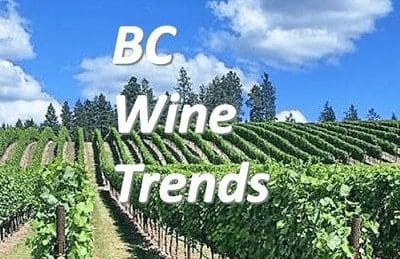With the 2020 BC Wine Grape harvest started, here is a look back at the key findings from the 2019 BC Wine Grape crop report.
The metrics for the 2019 Vintage are based on responses almost 80% of the BC Mainland wineries which is a similar response to 2018. The data collected is only for the BC Mainland wineries.

Annual Crop Assessment
The 2019 vintage was an average growing year with an unseasonably warm January followed by cold events in February that resulted in bud damage, crop loss and even vine loss in some instances, lowering the overall yield. The season was thankfully wildfire and smoke-free. Growing Degree Days (GDD) for all areas were close to 20-year averages; however, an early frost in October saw a dramatic loss of leaves creating an earlier than anticipated harvest for some vineyards1.
You can find individual winemaker comments on the 2019 Vintage in these earlier posts – Winemaker’s Thoughts on BC Harvest 2019 and Winemaker’s Thoughts on BC Harvest 2019 – Take 2.
Tonnage Data
The graph below shows the BC Wine Grape tonnages that were harvested in 2019 for the top 13 varieties. Merlot for red grapes and Pinot Gris for white grapes retained their number one tonnage positions as for 2018.
The 2019 total ton produced was 16% lower than in 2018. So it is rather surprising that average grapes prices decreased slightly (0.4%) in 2019 from the previous year.

The following pie chart shows how the tons were distributed over the BC Mainland Wine Regions. 48% of the wine grape crop was grown in the Oliver Region, the same as in 2018.

Pricing
The following table shows how prices ($/Short Ton) were on average about the same as 2018.
| Varietal | 2018 | 2019 | YOY Increase |
| Cabernet Franc | 3007 | 2864 | -4.8% |
| Cabernet Sauvignon | 3064 | 3041 | -0.8% |
| Chardonnay | 2470 | 2443 | -1.1% |
| Gamay Noir | 2428 | 2540 | 4.6% |
| Gewurztraminer | 2192 | 2158 | -1.6% |
| Merlot | 2940 | 2921 | -0.6% |
| Pinot Blanc | 2074 | 2102 | 1.4% |
| Pinot Gris | 2293 | 2267 | -1.1% |
| Pinot Noir | 2791 | 2818 | 1.0% |
| Riesling | 2208 | 2199 | -0.4% |
| Savignon Blanc | 2254 | 2250 | -0.2% |
| Syrah / Shiraz | 3181 | 3231 | 1.6% |
| Viognier | 2684 | 2612 | -2.7% |
| Average | 2584 | 2573 | -0.4% |
Gamay Noir saw the highest price increase at 5% and Cabernet Franc the largest decrease. Syrah maintained it’s top price position.
Here is a comparison to how the wine grape harvest went in the neighbourhood to the South. They reported similar growing season challenges. The Washington State wine grape harvest volume was almost 6 times that of British Columbia and the average BC wine grape price is 46% higher.
Washington State Grape Prices

Washington State’s wine grape harvest came in smaller compared to previous years, but the quality of the fruit picked was very high. The Washington State Wine Commission’s annual Grape Production Report, compiled with information provided by all Washington State wineries, showed 201,000 tons were harvested in 2019, a 23% decrease compared to the previous year.
“Mother Nature served a series of unfortunate frost events throughout the state in early to mid-October. Many winemakers and growers had already picked most or all of their fruit before the frosts, but for sites carrying higher yields, there was a good amount of fruit left unpicked due to concerns about frost damage.”
Steve Warner, President of Washington Wine.
Overall, the growing season was slightly cooler when compared to recent years, but on par with historical 20-year averages.
According to the grape report, Cabernet Sauvignon is still king in Washington at 53,740 tons or 27% of the total. Chardonnay was second at 33,540 tons or 17% of the total. Riesling, Merlot and Syrah rounded out the top five, which altogether equated to more than 80% of the crop. Red varieties accounted for 60% of the total production, which has remained roughly consistent over the past three years. Every variety saw a decrease in tons crushed in 2019 with the exceptions of Grenache and Pinot Noir, which each saw a small increase.
Farmers received an average of $1,315 per ton, which was an 8% increase over the previous year. Petit Verdot continues to receive the highest average price per ton at $1,876.
Conclusions
- The total 2019 BC wine grape tonnage decreased 16% from the previous year.
- The average 2018 British Columbia wine grape price was about the same as in 2018.
- The average BC wine grape price is 46% higher than Washington State.
- Gamay Noir saw the highest price increase of 5%.
- Merlot was the highest value varietal and 37% of the red grape crop.
- 48% of the mainland wine grapes were grown in the Oliver Region.
Acknowledgement
A special thank you to the BC Wine Grape Council for providing the detailed crop metrics for 2019.
References
- Annual Crop Assessment – 2019 Vintage prepared by the BC Wine Grape Council
- Washington reports great quality and lower yield for 2019 wine grape harvest.
